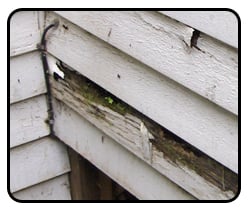This is part 3 of 3 in the series "Siding Curb Appeal--Selecting a Siding Product That Looks Good Now and Later". Download our whole siding comparison here.
Read Part 1: What Do The Seams Look Like?
Read Part 2: Does Your House Siding Actually Look Like Wood?
1. Dimensional Stability
Dimensional Stability is the measure of how well a product maintains its shape in different temperatures and humidity. Siding that has good dimensional stability isn’t affected by atmospheric changes as much as other types of siding. Painted cedar siding is beautiful when first installed, but it loses integrity and beauty quickly because it is so heavily affected by temperature and humidity.
Vinyl siding (made almost exclusively from PVC) has a very high rate of expansion and contraction. Vinyl siding can expand and contract up to a full inch between extreme warmth and cold. This constant fluctuation means vinyl siding often degrades in appearance quickly.
Tip: If you are concerned about long-term appearance, avoid products that are not dimensionally stable like wood siding and products with a higher rate of expansion such as vinyl siding.
2. Resistance to Moisture Damage
The second factor to consider when evaluating long-term attractiveness  is whether or not a product is prone to moisture absorption. Any product made from or containing wood has the inherent risk of moisture absorption. Moisture absorption will cause the surface paint to peel, deterioration, and delamination of layered products such as fiber cement.
is whether or not a product is prone to moisture absorption. Any product made from or containing wood has the inherent risk of moisture absorption. Moisture absorption will cause the surface paint to peel, deterioration, and delamination of layered products such as fiber cement.
Tip: If you are worried about peeling, delamination, and deterioration, then stay clear of products made from or containing ANY wood particles such as wood clapboards, pressed board and fiber cement.
3. Resistance to Impact Damage
Most homeowners fail to remember how much abuse one’s siding will actually face over time. Siding can be damaged by: hail, wind, ice, sleet, falling tree branches, sunlight, toys, balls, other projectiles, and rocks kicked-up from lawn mowers or passing cars. Painted products may hold up to the impact but will often show a chip in the painted surface thus revealing the off-color material underneath the paint.
Tip: Always consider the long-term durability of the siding product you choose and a product that is colored-through.
Download our whole siding comparison here.




